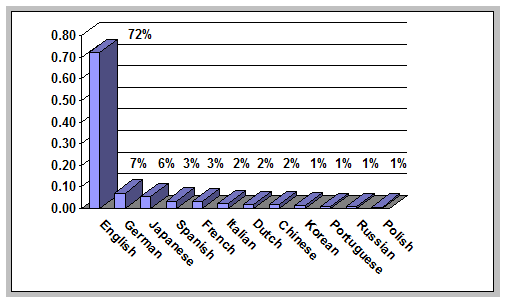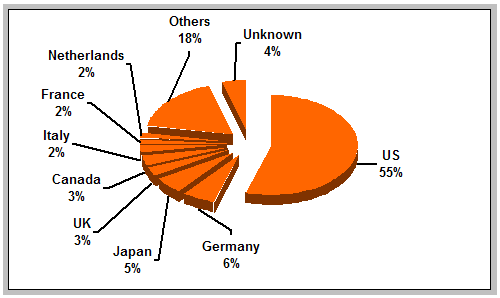overview
domains
content
population
traffic
navigation
demographics
methods
teledensity
ranks
divides
jargon
sources
lies & spin
industry
visualisation
analytics
pageviews
|
 demographics
demographics
This
page highlights studies of who is online and the value
of online activity.
It covers -
 where are the dollars?
where are the dollars?
Research into the economic size of the Web featured
at the 1999 US conference
on Understanding The Digital Economy: Data, Tools &
Research mentioned above. We recommend the papers
by Haltiwanger and Varian in particular. Our economy
guide discusses particular issues in more detail and concludes
with detailed statistical references.
Material at the Vanderbilt Uni eLab
site is also of value. At a global level the 1997 OECD
report
on Measuring Electronic Commerce remains of value.
Measuring the Internet Economy, the October 1999 report
by the University of Texas and Cisco, was decidedly upbeat
but worth examination for economic projections. It is
available at the Internet
Indicators site.
Lada Adamic & Bernardo Huberman in their May 1999
paper
The Nature of Markets in the World Wide Web - based
on an examination of 120,000 sites - argue that statistics
for visits to sites are characteristic of a winner-take-all
market.
Whether that will remain the case in future is unclear;
we believe that effective marketing online and offline
will offset disadvantages faced by many Australian sites
that are not 'winning' the traffic. The analysis is extended
in Huberman's The Laws of the Web: Patterns in the
Ecology of Information (Cambridge: MIT Press 2001).
In July 2000 Internet Ratings Report from Nielsen//NetRatings,
the online audience measurement service from the ACNielsen
and NetRatings partnership, argues that web usage in the
US has reached 'critical mass', with 52% of the population
having net access and 32% of the home population web surfing
in July. Nearly 144 million people in the US accessed
the net at home, compared to 106 million in the preceding
year, a growth rate of 35%. A similar picture is painted
in the February 2001 report (PDF)
from the Pew Internet Project.
US users spent nearly ten hours a month online, an increase
of 26 percent over the past year. Page views have doubled
over the past year from 353 to 709 page views per month.
Unique sites, however, have declined from 12 unique sites
visited in July 1999 to 10 unique sites visited in July
2000.
A spokesperson said
while
Web usage has increased, the number of sites people
visit has dropped in the past year. This means that
the barrier to entry is higher for new Internet ventures
as companies vie for surfers’ attention
and
went on to attribute the growth in access to "lower
prices for personal computers and competitive rates for
high-speed Internet access …. making it possible for the
mainstream consumer to log on."
New research from Media Metrix suggests that gender levels
on the Internet reached 31.1 million men and 30.2 million
women in April.
The number of women going online is outstripping the number
of men going online, and that the Internet has become so
mainstream that the average Web surfers are now in their
mid 40s. Women over 55 represent the fastest-growing cohort
on the Internet, up to 3.19 million in April, a 98.1 percent
increase over 1999. Teens were the second-fastest growing
age group. The same report highlights that the
United States dominates Web usage, boasting more Web users
than the next 15 countries combined.
 making sense of language statistics
making sense of language statistics
Estimates about languages online and offline are contentious.
That is unsurprising, given disagreement about the size
and shape of the global online
population.
As of 2004 around 6,809 'living' languages in the world,
with around 250 spoken by over a million people and 90%
spoken by fewer than 100,000 people.
In terms of population size the dominant language is Mandarin,
officially spoken by most Chinese. It is followed by English,
Spanish, Hindi and Arabic. In 1950 around 9% of the world's
population spoke English as a first language; that is expected
to decline to under 5% by 2050. English, however, appears
to have a cultural dominance beyond the number of 'first
speakers'. That reflects its use in business and science
and its resultant status as the second language of choice
(with a significantly higher number of people reading English
as a second language than speaking it fluently).
Some languages are rarer: it has been suggested that there
are 357 languages with under 50 speakers and that 46 are
known to have just one native speaker.
An estimated 4.5% of the total number of described languages
have disappeared over the the past 500 years, for example
over 31 of more than 235 languages spoken by Indigenous
Australians. Disappearance has reflected the disappearance
of particular groups - with smallpox for example resulting
in the extinction of many languages in the Americas - and
their adoption of other cultures.
A perspective is provided by David Crystal's Language
& The Internet (Cambridge: Cambridge Uni Press
2001), Vanishing Voices: The Extinction of the World's
Languages (Oxford: Oxford Uni Press 2000) by Daniel
Nettle & Suzanne Romaine, Empires of the Word: A
Language History of the World (London: HarperCollins
2005) by Nicholas Ostler, Endangered languages
(Oxford: Berg 1991) edited by Robert Robins & Eugenius
Uhlenbeck and Language, Mind and Nature (Cambridge:
Cambridge Uni Press 2007) by Rhodri Lewis.
 what languages are online
what languages are online
GlobalReach, an internet marketing company, has published
figures on the languages used by those online. Those figures
are inconsistent with some of the data featured on this
page. They suggest that the online global language populations
(in millions) from 1996 to 2005 were -
Eng
Chi
Jap
Spa
Ger
Fren
Ital
Scan
Kor
Port
Dut
other
Total |
40
0.1
2.0
0.2
0.5
0.2
0.1
2.0
0.01
0.02
0.05
7.0
50 |
72
1.2
7
0.8
3.5
2
0.5
2.2
0.05
0.2
1
11.4
117 |
91
2
9
1.8
6.3
3.4
1.8
3.2
0.8
1.2
2
15.1
151 |
148
10
20
13
14
9.9
9.7
7.7
5
4
5.8
6.4
245 |
192
31
39
21
22
17
12
9
17
11
7
28.8
391 |
231
48
48
35
37
18
20
11
25
14
11
41
529 |
233
78
61
50
43
23
24
14
28
19
13
64
626 |
288
103
70
66
53
28
24
15
30
26
12
89
729 |
280
160
85
70
62
40
35
16.3
35
32
13.5
129
941 |
300
220
105
80
71
49
42
17
40
38
15
142
1100 |
Inktomi's
January 2000 webmap
identified 1.6 billion pages, of which 86.55% were in
English, German 5.83%, French 2.36%, Italian 1.55%, Spanish
1.23%, Portuguese 0.85%, Dutch 0.54%, Finnish 0.50%, Swedish
0.36% and Japanese 0.34%. Other languages bring the total
to over 100%.
Agence de la Francophonie's 2001 L5 Fifth Study on
Languages & the Internet report
covered the presence on the net of English, German, and
the Romance languages. A Global Reach study
considered the number of users per language, as did a
set of global/regional reports (of varying quality) highlighted
by Nua. Global Reach suggested that as of 2001 the proportion
of the online population with English as the first language
is 43%, Chinese 9.3%, Japanese 9.2%, Spanish 6.7%, German
6.7%, Korean 4.4%, Italian 3.8%, French 3.3%, Portuguese
2.5%, Dutch 2.2% and 'Other' 8.9%.
The Estadísticas de Internet en el ámbito internacional
Madrid published a report
emphasising Spanish and other Romance languages but restricted
to select Western European languages. Gregory Grefenstette
& Julien Nioche's 2000 paper (PDF) Estimation of
English and non-English Language Use on the WWW covered
the number of words rather than pages per language, albeit
quite selectively. Peter Gerrand's 2007 'Estimating linguistic
diversity on the Internet: A taxonomy to avoid pitfalls
and paradoxes' paper
in 12 Journal of Computer-Mediated Communication
4 is of value.
The 2003 paper
Trends in the Evolution of the Public Web 1998-2002
by Edward O'Neill, Brian Lavoie & Rick Bennett suggested
that as of June 2002 the percentage of 'surface web' (ie
publicly accessible) sites by language was -

with
the percentage by site owner estimated as -

A
mid-2003 report by BlogCensus on blogs claimed that of
701,150 "sites we think are weblogs", some 380,657
appeared to be in English.
The next most popular languages in the blogosphere were
supposedly -
Language
Portuguese
Polish
Farsi
French
Spanish
German
Italian
Dutch
Icelandic |
Number
of blogs
54,496
blogs
42,677
27,002
10,381
9,509
7,736
7,017
3,684
3,542 |
That
claim is significantly at odds with other estimates of
the online population. As we have noted in discussing
blogging, Iceland appears
to have the highest per capita penetration of blogs.
A perspective is provided by Susan Herring's 2002 ppt
The language of the Internet: English dominance or
heteroglossia? and the 2005 UNESCO Measuring
Linguistic Diversity on the Internet study (PDF).
 next page (methodologies)
next page (methodologies)
|
|